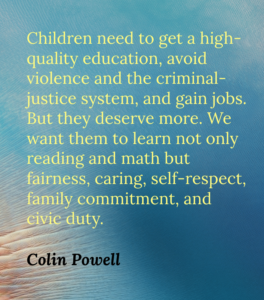 Early in my career as a teacher, one of my 9th grade students came early to my 8th period class to explain why she had been absent for the past week. She’d tried to end her life with a bottle of pills. She was found barely in time for medical intervention. I was in shock. I had known this young lady since 2nd grade. I saw her as bubbly, funny, hard-working, and never a problem. I only knew what I saw in class. After speaking to a colleague, I realized how totally unaware I was of the turmoil of her home life or her relationship with her classmates. Why did she confide in me? I was shaken to the core as an educator.
Early in my career as a teacher, one of my 9th grade students came early to my 8th period class to explain why she had been absent for the past week. She’d tried to end her life with a bottle of pills. She was found barely in time for medical intervention. I was in shock. I had known this young lady since 2nd grade. I saw her as bubbly, funny, hard-working, and never a problem. I only knew what I saw in class. After speaking to a colleague, I realized how totally unaware I was of the turmoil of her home life or her relationship with her classmates. Why did she confide in me? I was shaken to the core as an educator.
I realized how little I actually knew my students and felt ill-prepared to help in an emotional crisis. How could I help any student – would I be able to talk anyone back from the ledge? I contacted a friend, a mental health counselor, for guidance and shared my emotional reaction to the student’s “news”. (I had cried and told her to talk to someone before throwing away her life.) He felt that my genuine reaction had been the right thing to do. Showing my natural reaction revealed how much I cared. This, however, didn’t bolster my confidence.
Awareness is the first step.
My life since then has been a quest for better understanding students’ mental health and be alert to those at risk. It was a tall order for a mere mortal, but it has lead me to a better understanding of resilience and mental health crises in young people and how teachers can help. The first step is for teachers to be more aware of mental health concerns of our youth.
We have all known at least one caring adult in our own childhood who made a significant difference on our path to adulthood and beyond. Many of us can name several – including parents, other relatives, and sometimes neighbors, pastors, and teachers. Of all of these, teachers are in a unique position to provide a significant influence on their students’ perspectives on life, their future and beliefs.

The image of a generation of aspiring students and successful adulthood because of a caring teacher has dimmed in light of consternation over childhood mental health statistics and events in the news. This year May 6th was named “National Children’s Mental Health Awareness Day” with a focus on suicide prevention. For youth ages 10 – 24, suicide is the second leading cause of death after accidental death. In the United States, the number of people suffering from serious mental-health issues has skyrocketed since 2009. The suicide rate for teens ages 14 to 17 shot up by more than 60 percent between 2009 and 2017, and there have been sharper increases among girls than boys. [1]
A closer look at death statistics reveals more about the experience of childhood today. For children aged 1-9, the fourth leading cause of death is homicide. Suicide is the second leading cause for ages 10-14, and homicide slides into fifth place. For 15-19 year olds, suicide retains its second place status and homicide rises to third leading cause of death. One begins to realize that childhood is not as idyllic and carefree as once believed by previous generations. In fact, I postulate that the violence children experience is directly related to the numbers of suicides for this age group.
Learning from the Adverse Childhood Experiences Study
Indeed, new research as a result of the Adverse Childhood Experiences Study (ACEs) from the CDC, have brought forth new documented evidence of the numbers of children who experience trauma and the far-reaching impact of traumatic stress on their mental and physical well-being. Domestic violence is a common precursor for homicide of infants and children. 1 in 15 children are exposed to intimate partner violence each year, and 90% of these children are eyewitnesses to this violence. [2]
It’s difficult to refer to this mental health issue as Post-Traumatic Stress Disorder, because this is complex trauma. PTSD seems to indicate that the trauma has ended. But for childhood trauma, it is likely to be an on-going, day-to-day struggle to survive abuse from people they either live with or cannot otherwise avoid. These children endure a living hell. Intervention by Child Protective Services or placement with a foster family doesn’t automatically make the trauma go away. The emotional scars affect the child’s self-image, ability to envision a future or the capacity to relate to their peers and other adults. On any given day, any number of things could trigger a memory – sounds, tone of voice, scent, or touch – resulting in a physical and emotional reaction that overwhelms the child’s senses and coping skills.
Educators recognize dysregulation
What teachers and principals are likely to see is the emotional and behavioral dysregulation in a school age child. I hesitate to use the term “mental health problems” when speaking to teachers. Only a licensed mental health provider has the training and authority to make a diagnosis of a mental health problem. I prefer to use the word “dysregulated” with educators and focus on the observable behaviors that are outside the expected norms at school.
Children’s behaviors are initiated from within their thinking processes and arise in response to a stimulus around them. These statistics from the CDC indicating the level of violence and trauma experienced by children confirm what we educators witness in student behaviors ranging from withdrawal, social awkwardness, learning difficulties, anxiety, disruptive and disrespectful behaviors and even destructive outbursts. Statistics on children’s mental health ages 3 to 17 show 7.4% have a diagnosed behavior problem, 7.1% with a diagnosis of anxiety, and 3.2 % diagnosed with depression.[3]
The operative word is “diagnosed”. The CDC report states that these rates are estimates based on parent reports. The consensus is that these estimates are much lower than the true number of children with a mental health issue. Sadly, not all children with a diagnosis actually receive treatment. A child’s age and poverty level affects the likelihood of receiving treatment.
What Educators Can Do to Mitigate Mental Health Concerns
Educators should not despair that these dire statistics are the new normal for our youth. The major mitigating factor that fosters resilience and reduces the impact of trauma on our children and youth is a caring, self-regulated adult who builds a positive developmental relationship. Based on over fifty years of research, The Search Institute provides teachers, principals, youth leaders, and parents a list of specific and appropriate actions that help all students become more resilient.

Where there is a caring heart, there is hope for tomorrow.
The Developmental Relationships Framework articulates actionable insights for adults through five elements of relationships that contribute to a young person’s growth, learning, and thriving. These are: expressing care, challenge growth, provide support, share power, and expand possibilities. Expressing care includes actions such as really listening, being warm, encouraging, and dependable. Sharing power means being respect them, take them seriously and involve them in decisions that affect them.
While I strived to be a kind and caring teacher, that’s only a starting point. Our students deserve the time and effort it takes for us educators to better understand Adverse Childhood Experiences. We should all know how to build the developmental relationships that can help students thrive. Become more informed and remember that the behaviors you see may not be what they appear to be. Check in with your students and be prepared to listen. Know your school counselors and don’t hesitate to ask about a student who concerns you. After all, teachers don’t teach a subject, they teach people. And people come first.
To see all the developmental relationship elements with the actions to take and examples of each, visit www.search-institute.org/developmental-relationships.
______________
[1] Washington Post, June 11, 2019 “Her death made headlines. We should learn from her life, instead.” Accessed June 14th, 2019 https://www.washingtonpost.com/opinions/2019/06/12/her-story-isnt-about-euthanasia-its-about-failing-mental-health-systems/?utm_term=.4520d2e503bd
[2] The Juvenile Justice Bulletin, 2011, accessed June 14, 2019 https://www.ncjrs.gov/pdffiles1/ojjdp/232272.pdf
[3] https://www.cdc.gov/nchs/slaits/nsch.htm
